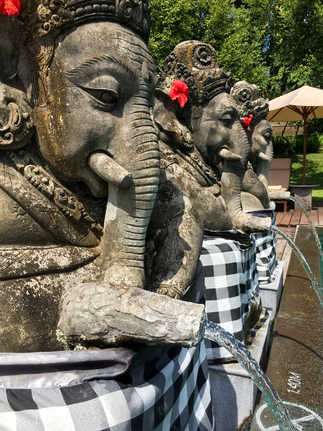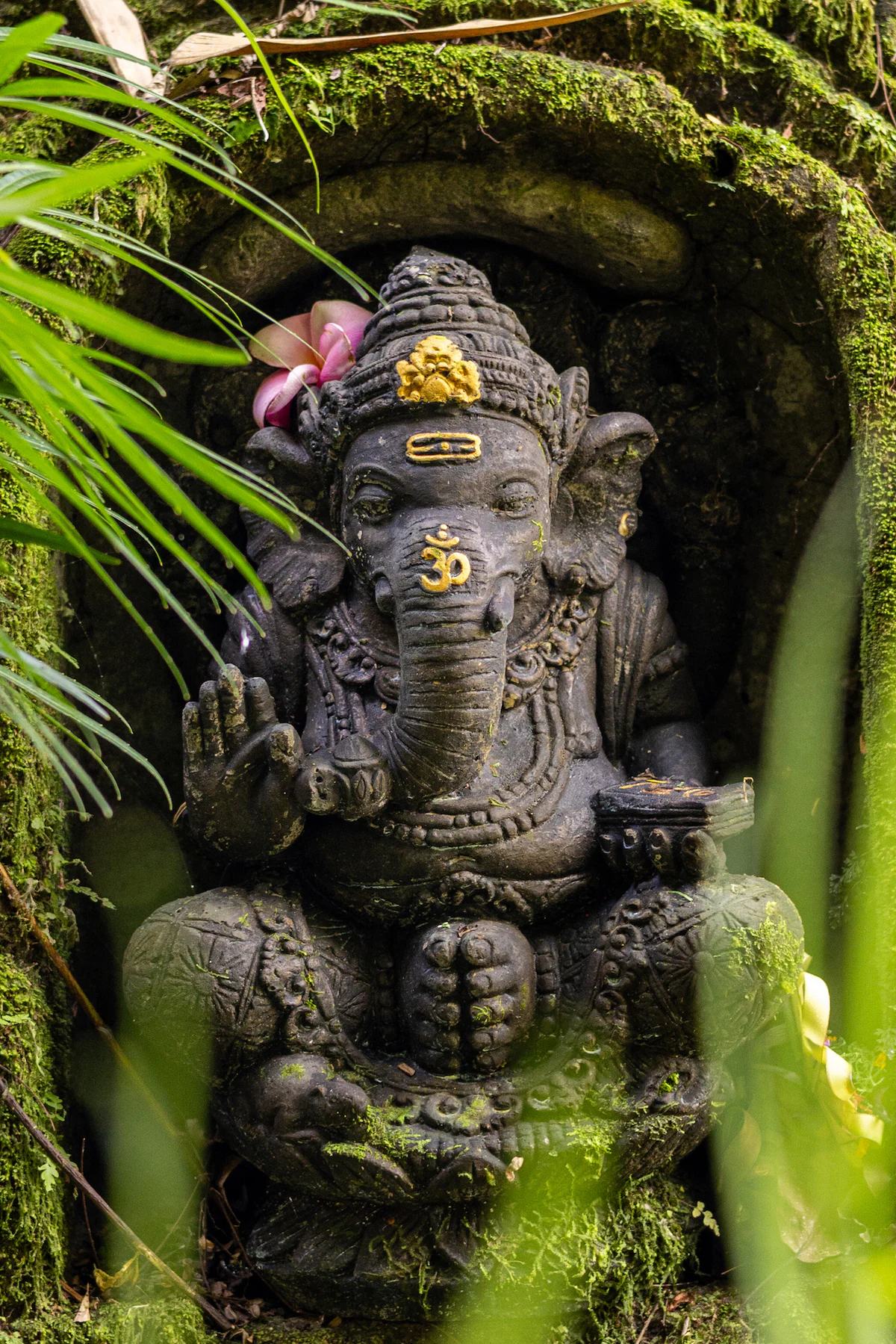Ganesha - The Remover of Obstacles
- shan157
- 2 days ago
- 4 min read
In the moss veiled temples of Bali, Ganesha is far more than a familiar Hindu icon, he is a living force who moves between light and shadow. Though his roots lie in Indian Hinduism, Bali’s Ganesha (also known as Batara Gana) has taken on new dimensions, shaped by animist spirits, local rituals and the Balinese understanding of cosmic balance. While globally known as the Remover of Obstacles (Vighnaharta), here he also becomes a gatekeeper of haunted paths, a punisher of arrogance and a guardian of inner order. Clad in symbolic power, Ganesha is often shown with a fractured tusk, a coiled noose, a sharpened blade and a sweet offering, each one a fragment of his paradox: destruction with restraint, temptation met with wisdom and chaos tamed by clarity.

Ganesha’s distinctive elephant head carries rich symbolism that extends beyond its Indian origins, gaining unique significance in Balinese spiritual thought. The well known story of his beheading by Shiva and subsequent revival with an elephant’s head serves in Bali as a powerful allegory for personal transformation, the surrender of ego and the emergence of higher awareness. In Balinese rituals, the elephant symbolises qualities highly valued in the path of devotion, steady patience, deep remembrance and enduring strength. Ganesha’s broad ears represent attentive listening, not just to spoken prayers but to the subtle currents of unseen realities, while his sharp eyes embody focused insight that can penetrate confusion and illusion. Far from a simple combination of human and animal, his form reflects the ongoing balance between primal instincts and enlightened consciousness, reminding devotees that true wisdom often requires sacrifice and a willingness to transcend one’s former self to achieve spiritual maturity.
His arrival on the island dates back to early Indian contact but it was the migration of the Majapahit Empire in the mid 14th century that firmly embedded Ganesha into Bali’s sacred landscape. Over time, he was absorbed into Agama Hindu Dharma, a unique form of Hinduism that blends traditional Hindu beliefs with indigenous Balinese animistic practices and ancestor worship. Ganesha was seamlessly woven into temple design, family compounds and ritual life. Yet unlike in India, where his image is often playful or auspicious, Balinese depictions of Ganesha carry weight. He is covered in moss, seated in silence and often cloaked in a black-and-white poleng cloth, as a reminder that balance is not guaranteed but maintained.

Ganesha’s image is commonly found at entrances of caves, temples, homes and crossroads, places seen as spiritually vulnerable. These thresholds mark the boundary between the physical and unseen realms, where buta kala (chaotic spirits) are believed to roam. In Bali, Ganesha statues typically face north, as it aligns with Lord Shiva, Ganesha’s divine father and the source of his power. At Goa Gajah Temple near Ubud, a Ganesha statue guards the sanctuary’s core, serving not just as decoration but as a spiritual protector that restrains chaos and ensures rituals proceed smoothly. The Balinese don't just honour Ganesha for what he removes but for what he restrains. In some of Bali’s more secluded forest temples, Ganesha statues are often partially reclaimed by nature, covered in moss, weathered by rain and surrounded by dense vegetation. While not fearsome in form, their setting evokes a quiet power. These shrines, often tucked away from the main roads and far from tourist paths, carry a weight of stillness and ancestral presence, quietly overseeing the forest and gently maintaining the harmony of energies that might otherwise drift into disorder.

Beyond his role as a protector and gatekeeper, Ganesha is also deeply connected to learning, writing and the creative arts. In Hindu lore, he is the divine scribe who penned sections of the Mahabharata using his broken tusk, a symbol of sacrifice in pursuit of knowledge. This connection carries strongly into Balinese culture, where students, dancers, painters and craftsmen often seek Ganesha’s blessing before beginning a new project. His energy is believed to sharpen focus, inspire creativity and remove the subtle internal resistance that blocks learning. In Balinese schools, children grow up with stories and imagery of Ganesha not as an abstract deity but as a personal guide, woven into dance routines, drawings and lessons that tie learning to spiritual growth. His presence reminds them that wisdom is not inherited but built through patience, clarity and devotion.
Ganesha’s role in Bali doesn’t end with the living. During ngaben, the island’s sacred cremation rites, some priests quietly include him in their offerings, not as a celebrant of death but as a guide through it. His presence is said to shield the departing soul from spiritual interference, steering it past ancestral unrest and into safe passage. In more remote regions, Ganesha is viewed not merely as a protector but as a course corrector, a force that interrupts when someone strays from dharma. A sudden illness, delay or personal loss may be interpreted not as punishment but as a divine recalibration meant to steer the spirit back into balance. In Balinese belief, divine power responds to intention. Ganesha is not a passive symbol to be invoked on command, his energy requires upkeep. A dusty shrine, an unoffered praye, or careless ritual isn’t just disrespect, it’s a fracture in the spiritual fabric. His blessings arise through deliberate action, cleansing, preparing and offering with clarity of mind. Especially in family compounds and mountain temples, statues of Ganesha are regularly bathed, dressed and spoken to, not to attract wealth or luck but to uphold a fragile, living contract between the sacred and the everyday.

In Bali, Ganesha is far more than a deity to be invoked in moments of need. He is a constant presence woven into the fabric of daily life and spiritual practice. His image, weathered by time and nature, reminds devotees that sacred power demands ongoing respect and balance, not just fleeting prayers. Acting as a bridge between worlds seen and unseen, Ganesha embodies the fragile harmony that sustains existence, quietly watching, testing, and protecting with equal measure. To honour him is to acknowledge that true wisdom and spiritual growth come from patience, humility and an unending commitment to walk the path with reverence, knowing that the journey itself is as vital as any destination.
Thanks for reading about Ganesha - The Remover of Obstacles. Check out more legends here!

Standing at 46 metres tall, this statue at Taman Safari Marine Park is among the tallest representations of Ganesha in the world
















































